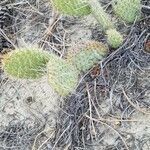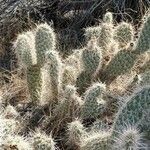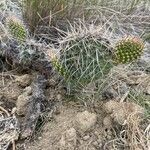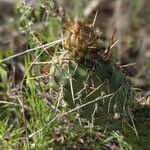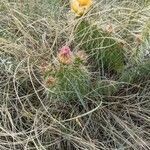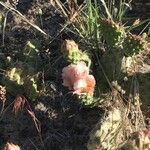More or less erect shrub 0.5–1.5 m high, to 3 m diam. Stem segments firmly attached, elliptic to narrowly to broadly obovate to circular, compressed, not tuberculate, 4–15 (–25 ) cm long, 2–8 (–12) cm wide, 5–10 mm thick, grey-green, dull, minutely papillate. Areoles close set, 30–50 per stem segment face, 5–12 mm apart, oval to semi-circular, 3–6 mm wide, with wool pale creamish to pale brown. Leaves succulent, terete, conical, 2–3 mm long, caducous. Spines very variable (in U.S.A.), on all or almost all areoles on the stem segment, terete to flattened in cross-section, stout to acicular to bristlelike, straight to curling, of one or two types; if one type: 0–18 per areole, spreading and curling irregularly, sometimes straight, erect, ascending to reflexed, yellow to dark brown to black, ageing grey, pink-grey to grey-brown, longer (35–) 40–90 (–185) mm long, 0.3–0.8 (–1) mm wide at base; if ± two types: longer spines (0) 1–5, reflexed to porrect, yellow-brown to brown to grey, longest 20–150 mm long; smaller spines (0–) 5–11, reflexed, white to white-grey, longest 4–16 mm long, not barbed. Glochids in narrow, tidy crescent at adaxial edge of areole or in broad, brushy crescent and tuft, 2–10 mm long (few and short on younger stem-segments, numerous on older pads), yellow to reddish, ageing brown. Flowers 40–75 mm diam.; outer tepals green, rose or yellow, succulent, ovate to obovate, somewhat undulate, the apex mucronate or acuminate; inner tepals yellow (in Australia), widely spreading, broadly cuneate to cuneate-obovate, 25–40 mm long, 12–15 mm wide, the apex truncate or retuse, mucronate; staminal filaments pale yellow, anthers pale yellow; style white to pale yellow, stigma lobes green; pericarpel (at anthesis) slightly tuberculate, spiny. Fruit solitary, long persistent, obovoid-cylindric, 25–45 mm long, 12–25 mm diam., slightly tuberculate, umbilicus shallow, all or only distal areoles bearing 3–16 spines, the spines 4–20 mm long, the fruit maturing to carmine, succulent but not juicy, inedible. Seeds oblong to subcircular, flattened, 3–7 mm long, 2–4 mm wide, tan to grey.
More
Shrubs, low, 10-25 cm, with ± prostrate branches. Stem segments not easily detached, green, elliptic to narrowly to broadly obovate to circular, 4-27 × 2-18 cm, low tuberculate; areoles 4-14 per diagonal row across midstem segment, subcircular, 3-6 mm; wool tan to brown. Spines at all or only distal areoles of stem segment, terete to flattened, stout to acicular to bristlelike, straight to curling, of 1 or 2 kinds; if 1 kind: 0-18 per areole, spreading and curling in various directions, sometimes straight, erect, ascending to deflexed, yellow to dark brown to black, turning gray, pink-gray to gray-brown, longest (35-)40-90(-185) mm; if ± 2 kinds: major spines (0-)1-5, reflexed to porrect, yellow-brown to brown to gray, longest 20-150 mm; minor spines (0-)5-11, deflexed, white to white-gray, longest 4-16 mm. Glochids inconspicuous, in narrow, tidy crescent at adaxial edge of areole or in broad, brushy crescent and tuft, yellow to reddish, aging brown, to 10 mm. Flowers: inner tepals yellow to magenta throughout, 25-40 mm; filaments white, yellow, or red to magenta (flowers may superficially appear bicolored); anthers yellow; style white to pale pink; stigma lobes green. Fruits tan to brown, ± cylindric, 15-45 × 12-25 mm, dry at maturity, glabrous, sometimes burlike; areoles 10-33, each or only distal areoles bearing 3-16 spines, 4-20 mm. Seeds tan to gray, flattened, warped, oblong to subcircular, 3-7 × 2-4 mm; girdle protruding 1-2 mm.
A cactus. It forms mats, It grows 30 cm high and spreads 1.2 m wide. The stem segments are rounded but flat. They are 10 cm long. They have clusters of 5-10 blue-green spines. These are 5 cm long. The flowers are yellow to yellow-green. The fruit are dry and rather spiny and 25 mm long.
A similar western sp. with 6–10 spines per areole and dry frs, has been reported e. to Wis. and Mo.
